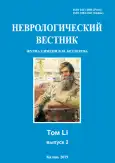Structure and dynamics of the emotional burnout syndrome in medical workers during correction with mindfulness technology
- Authors: Ovchinnikov A.A.1, Sultanova A.N.1, Vinokurov A.V.1, Sycheva T.Y.1, Tagiltseva E.V.1
-
Affiliations:
- Novosibirsk State Medical University
- Issue: Vol LI, No 2 (2019)
- Pages: 44-48
- Section: Original study arcticles
- URL: https://journals.rcsi.science/1027-4898/article/view/15661
- DOI: https://doi.org/10.17816/nb15661
- ID: 15661
Cite item
Full Text
Abstract
The objective of this study is research of structure and dynamics of the emotional burnout syndrome among health care workers in the process of applying the mindfulness technique. It is revealed that in the course of correction the phenomena relating to the emotional sphere – emotional exhaustion, situational anxiety and catastrophization significantly change. Identification of relationships showed a clear structure of the emotional burnout syndrome. This structure contains a catastrophization in addition to the three components. In this structure catastrophization and reduction of professionalism are the coping strategies against emotional exhaustion and depersonalization.
Full Text
##article.viewOnOriginalSite##About the authors
Anatoly A. Ovchinnikov
Novosibirsk State Medical University
Author for correspondence.
Email: sultanova.aklima@yandex.ru
Russian Federation, 630091, Novosibirsk, Krasny Prospekt, 52
Aklima N. Sultanova
Novosibirsk State Medical University
Email: sultanova.aklima@yandex.ru
Russian Federation, 630091, Novosibirsk, Krasny Prospekt, 52
Alexander V. Vinokurov
Novosibirsk State Medical University
Email: sultanova.aklima@yandex.ru
Russian Federation, 630091, Novosibirsk, Krasny Prospekt, 52
Tatyana Yu. Sycheva
Novosibirsk State Medical University
Email: sultanova.aklima@yandex.ru
Russian Federation, 630091, Novosibirsk, Krasny Prospekt, 52
Elena V. Tagiltseva
Novosibirsk State Medical University
Email: sultanova.aklima@yandex.ru
Russian Federation, 630091, Novosibirsk, Krasny Prospekt, 52
References
- Козин В.А. Факторы, влияющие на развитие синдрома эмоционального выгорания у врачей-наркологов в амбулаторной и стационарной практике // Неврологический вестник. 2013. №4. С. 78–80.
- Менделевич В.Д. Клиническая и медицинская психология: Практическое руководство. М.: МЕДпресс, 2001. 592 с.
- Менделевич В.Д. Спектры психических расстройств и проблема терапевтического релятивизма // Неврологический вестник. 2017. №4. С. 11–20.
- Менделевич В.Д., Граница А.С. Прогнозирование будущего и механизмы неврозогенеза. Часть 2. // Неврологический вестник 2014. №1. С. 51–57.
- Chaoping L., Kan S., Zhengxue L. et al. An investigation on job burnout of doctor and nurse // Chinese J Clin Psychol. 2003. N 03. P. 170–172.
- Fuchs S., Endler P.C., Mesenholl E. et al. Burnout bei niedergelassenen Ärztinnen und Ärzten für Allgemeinmedizin // Wien Med Wochenschr. 2009. Vol. 159(7–8). P. 188–191. doi: 10. 1007/s10354-009-0669-5.
- Humphries N., Morgan K., Conry M.C. et al. Quality of care and health professional burnout: narrative literature review // Intl J Health Care Quality Assurance. 2014. Vol. 27(4). P. 293–307. doi: 10. 1108/IJHCQA-08-2012-0087.
- Kase S.M., Waldman E.D., Weintraub A.S. A cross-sectional pilot study of compassion fatigue, burnout, and compassion satisfaction in pediatric palliative care providers in the United States // Palliat Support Care. 2018. 1–7. PMID: 29397055.
- Le Blanc P.M., Hox J.J., Schaufeli W.B. et al. Take care! The evaluation of a team-based burnout intervention program for oncology care providers // J Appl Psychol. 2007. Vol. 92(1). P. 213–227. doi: 10. 1037/0021-9010. 92. 1. 213.
- Marques M.M., Alves E., Queiros C. et al. The effect of profession on burnout in hospital staff // Occup Med. 2018. Vol. 68(3). P. 207–210. doi: 10. 1093/occmed/kqy039.
- Maslach C., Jackson S.E. The measurement of experienced burnout // J Organ Behav. 1981. Vol. 2(2). P. 99–113. doi: 10. 1002/job.4030020205.
- Maslach C., Schaufeli W.B., Leiter M.P. Job burnout // Annu Rev Psychol. 2001. Vol. 52(1). P. 397–422. doi: 10. 1146/annurev.psych.52. 1. 397.
- Maslach C., Leiter M.P. Understanding the burnout experience: recent research and its implications for psychiatry // World Psychiatry. 2016. P. 15(2). P. 103–111. doi: 10. 1002/wps.20311.
- Schult T.M., Mohr D.C., Osatuke K. Examining burnout profiles in relation to health and well-being in the veterans health administration employee population // Stress Health. 2018. Vol. 10. 1002/smi.2809.
- Seidler A., Thinschmidt M., Deckert S. et al. The role of psychosocial working conditions on burnout and its core component emotional exhaustion-a systematic review // J Occup Med Toxicol. 2014. Vol. 9(1). P. 10. doi: 10. 1186/1745-6673-9-10.
- Shirom A., Melamed S., Toker S. et al. Burnout and health review: current knowledge and future research directions. Illinois: Wiley, 2011. P. 269–308.
Supplementary files






